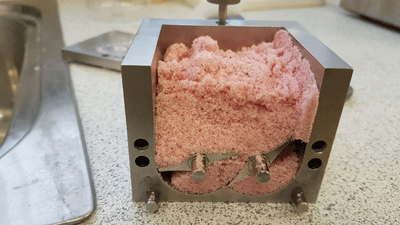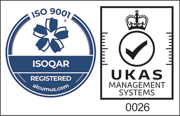Two different products were tested to help a customer who was finding some difficulty in obtaining homogeneous mixes of small volumes. These materials were considered difficult to mix to a homogeneous state in the batch sizes required.
PRODUCT 1, TRIAL 1
A mix of sugar and salt in the ratio of 2:1
A batch of 100 grams of household sugar was weighed and added to the mixing bowl, together with a batch of 50 grams of table salt. A full sized standard bowl without the insert was used. Inserts are available and can be useful when smaller volumes are used, but were not necessary in this case.This batch was mixed for about 30 seconds at 125 rpm and it appeared that with this particular mix (with a tapped bulk density of 1.35) the mixing process worked, but was not optimum. This volume was a little too much to achieve very effective mixing quickly.
A sample of 25 grams was removed from the mixing chamber and the remaining batch of 125 grams was efficiently mixed within about 30 seconds with a mixing speed of 125 rpm. These observations were only by eye. In order to make visual inspection easier, 0.4ml of an aqueous red food dye was added to the sample. The sample was mixed for an additional 30 seconds at 125 rpm.
The qualitative results shown in the pictures below indicate that a thorough mix is achieved with samples with a mix time of about 90 seconds.
In the photograph below the mixing bowl is removed from the Mixer/Granulator base and the front plate is removed from the mixing bowl to allow a qualitative visual inspection of the mix.
A homogeneous mix of sugar and salt (ratio 2:1) with 0.4 ml of red food dye added for the last 30 seconds of mixing. The sample is clearly homogeneous demonstrating the mixing efficiency of the standard bowl with powders of unequal particle size and weight.
PRODUCT 1 - TRIAL 2
In a second trial with the same material the sigma blade system was used. In this case the mixing was significantly less efficient (it was taking longer). The picture below shows the mix state in the sigma bowl after 90 seconds. It is believed that the eventual effectiveness of the mixing would equal that of the standard blade set in this case but a longer mix time would be required.A homogeneous mix of sugar and salt (ratio 2:1) with 0.4 ml of red food dye added for the 90 seconds of mixing. The sample appears to take longer to reach a homogeneous mix than in the trial with the standard bowl and blade set. This is expected as the sigma blades were designed for mixing high viscosity materials and not dry powder mixing.
PRODUCT 2 - TRIAL 1
In a second set of trials an attempt was made to mix a fine oat bran (tapped bulk density 0.54) with “room temperature solid” palm oil with a melting point of about 80 degrees C.The standard bowl and blade set were used as the shear activity was considered important in case the palm oil began to solidify before being fully dispersed.
In this test the optional water jacketed bowl was not available and thus not used (but generally this would be recommended in such a case) but the bowl was heated before use by immersion in hot water (at about 80 deg C).
A batch size of 50 g of oat bran was added to the mixing bowl and the mixer run at 150 rpm. With the very low bulk density of the oat bran a 50 g batch was added to the mixer and it was already too full. A sample of 10 g was removed from the mixer and the mixing activity was good.
A 5 ml sample of liquid palm oil (heated in a water bath to approximately 80 degrees C) was taken into a 5 ml syringe and quickly added to the sample being mixed.
The mixer was allowed to run at 150 rpm for 10 minutes. After 10 minutes the resulting mixture had the appearance of being completely homogeneous.
The solidified oil caused a visible colour change which appeared homogeneous throughout the sample.
The image below shows a homogeneous distribution of a “room temperature solid” palm oil mixed for 10 minutes at a high speed in the mixing bowl of the Caleva Multi Lab. The standard blade and bowl set of the CML with it’s high shear mixing performance proved excellent for mixing a 5 ml sample of palm oil in a 40 gram batch of fine oat bran.
PRODUCT 2 - TRIAL 2
In the second trial the amount of oil added to the 40g of oat bran was increased to 8ml. The oil was added to the mix in 2 x 4 ml lots with the mixer running at 150 rpm. With the higher quantity of palm oil, and after 10 minutes there was some sticking of material on the mixing blades. This material was scraped from the blade and the material was mixed for an additional 2 minutes at 240 rpm. The additional mixing removed this small amount of material and the mix was homogeneous.In practice, this additional second mixing is a reasonable step in the few instances that it may be required. With the highest proportion of the “solid” palm oil in the 40 gram batch of fine oat bran the mix was homogeneous but in this case an additional second 2 minute mix was required.
PRODUCT 2 - TRIAL 3
In a final trial, 40 g of fine oat bran was mixed with 2 ml of palm oil for 10 minutes at 240 rpm. This smaller quantity mixed effectively and the resulting mixture was again homogeneous as shown below.
CONCLUSIONS
- The mixer/granulator component of the Caleva Multi Lab gives excellent performance as a standalone mixer for distributing small amounts of liquid through a fine powder matrix.
- It also offers excellent performance as a standalone mixer for mixing powder samples of different size and weight.
- The amount of the powder component that can be mixed in a single batch is dependent on the bulk density of the product. In the reported trials, using a product with a bulk density of 1.35 a batch of 125 g can be mixed effectively. A product with a bulk density of 0.54 a batch of 40 grams was effectively mixed.
- Oil can be effectively mixed even when the oil is a solid at room temperature. A water jacketed bowl would be an advantage and should be considered.
- A range of bowl sizes and blade designs are available and can be chosen depending on the properties of the materials to be mixed or granulated. Contact Caleva for additional advice.
- The Caleva Mixer/Blender/Granulator is suitable for use in industries such as pharmaceutical, chemical, catalyst, aquaculture and many others where small samples are required to be efficiently mixed together.



Leave A Comment